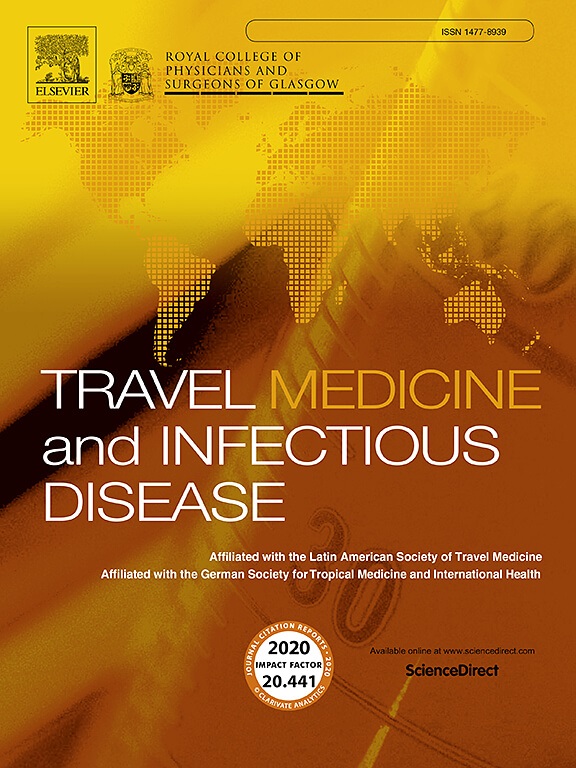ZIeKA monitor study: travel-related arbovirus infections among Dutch travellers, 2018–2020
IF 4.7
3区 医学
Q1 INFECTIOUS DISEASES
引用次数: 0
Abstract
Background
This study aims to estimate the incidence of arbovirus infections among Dutch travellers and subsequent potential risk of importation.
Methods
For this prospective, fully remote study, Dutch travellers visiting arbovirus endemic countries between August 2018 to March 2020 were recruited through (social) media and travel-clinics. Interested travellers could register online. Participants completed questionnaires and kept a daily symptom log during travel using a custom-made study app. Travellers reporting symptoms suggestive of arbovirus infection were invited to self-collect a dry-blood spot sample (DBS) upon return. In a sub-cohort of participants, post-travel DBS were also collected if asymptomatic. Participants mailed the DBS to the laboratory to be tested by PCR for ZIKV, DENV and CHIKV, along with IgG and IgM antibody testing.
Results
Of 1222 subjects registering online, 737 (60.3 %) completed the baseline questionnaire and ≥60 % of symptom diaries and were included in the analysis. Arbovirus-like symptoms were reported by 73 participants (9.9 %). A post-travel DBS was obtained from 67 symptomatic and 154 asymptomatic travellers. None were RT-PCR positive for ZIKV, DENV or CHIKV. Two symptomatic travellers were IgM positive indicating probable recent arbovirus infection. An additional ten cases were IgG positive/IgM negative suggesting possible previous arbovirus exposure. The estimated incidence proportion and rate of travel-related arbovirus infection were 2.7–16.3/1000 trips and 3.9–23.4/1000 person-months, respectively.
Conclusion
While a small proportion of travellers to arbovirus endemic areas have evidence of recent infection, the risk of arbovirus importation by returning travellers appears low as viraemia was not detected in any participant upon return.
ZIeKA监测研究:2018-2020年荷兰旅行者中与旅行相关的虫媒病毒感染
背景:本研究旨在估计荷兰旅行者中虫媒病毒感染的发生率以及随后输入的潜在风险。方法:在这项前瞻性、完全远程研究中,通过(社交)媒体和旅行诊所招募了2018年8月至2020年3月期间访问虫媒病毒流行国家的荷兰旅行者。有兴趣的旅客可以在网上注册。参与者使用定制的研究应用程序完成问卷调查,并在旅行期间记录每日症状日志。报告虫媒病毒感染症状的旅行者被邀请在返回时自行收集干血斑样本(DBS)。在参与者的亚队列中,如果无症状,也收集旅行后脑起搏器。参与者将DBS邮寄到实验室,通过聚合酶链反应检测ZIKV、DENV和CHIKV,以及IgG和IgM抗体检测。结果:在1222名在线注册的受试者中,737名(60.3%)完成了基线问卷和≥60%的症状日记,并被纳入分析。73名参与者(9.9%)报告了虫媒病毒样症状。对67名有症状和154名无症状的旅行者进行旅行后脑起搏器检查。寨卡病毒、DENV病毒或CHIKV病毒RT-PCR均无阳性。两名有症状的旅行者IgM阳性,表明最近可能感染了虫媒病毒。另有10例IgG阳性/IgM阴性,提示以前可能接触过虫媒病毒。旅行相关虫媒病毒感染率和感染率分别为2.7 ~ 16.3/1000人次和3.9 ~ 23.4/1000人月。结论:虽然前往虫媒病毒流行地区的一小部分旅行者有近期感染的证据,但返回旅行者输入虫媒病毒的风险似乎很低,因为返回时未在任何参与者中检测到病毒血症。
本文章由计算机程序翻译,如有差异,请以英文原文为准。
求助全文
约1分钟内获得全文
求助全文
来源期刊

Travel Medicine and Infectious Disease
PUBLIC, ENVIRONMENTAL & OCCUPATIONAL HEALTH-INFECTIOUS DISEASES
CiteScore
19.40
自引率
1.70%
发文量
211
审稿时长
49 days
期刊介绍:
Travel Medicine and Infectious Disease
Publication Scope:
Publishes original papers, reviews, and consensus papers
Primary theme: infectious disease in the context of travel medicine
Focus Areas:
Epidemiology and surveillance of travel-related illness
Prevention and treatment of travel-associated infections
Malaria prevention and treatment
Travellers' diarrhoea
Infections associated with mass gatherings
Migration-related infections
Vaccines and vaccine-preventable disease
Global policy/regulations for disease prevention and control
Practical clinical issues for travel and tropical medicine practitioners
Coverage:
Addresses areas of controversy and debate in travel medicine
Aims to inform guidelines and policy pertinent to travel medicine and the prevention of infectious disease
Publication Features:
Offers a fast peer-review process
Provides early online publication of accepted manuscripts
Aims to publish cutting-edge papers
 求助内容:
求助内容: 应助结果提醒方式:
应助结果提醒方式:


